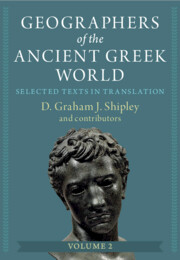Book contents
- Frontmatter
- Dedication
- Epigraph
- Contents
- PART IV: Roman Period
- PART V: Late Antique Period
- 32 Avienus (Avienius), Ora maritima (The Sea Coast)
- 33 Expositio totius mundi et gentium (Account of the Whole World and its Peoples) and Iunior Philosophus
- 34 Markianos of Herakleia
- 35 Hypotypōsis tēs geōgraphias en epitomēi (Outline of Geography in Summary)
- 36 Pseudo-Arrian, Circumnavigation of the Euxine
- Sources of Extracts (Selected)
- Works Cited
- Concordances
- Selective Index
32 - Avienus (Avienius), Ora maritima (The Sea Coast)
from PART V: - Late Antique Period
Published online by Cambridge University Press: 25 March 2024
- Frontmatter
- Dedication
- Epigraph
- Contents
- PART IV: Roman Period
- PART V: Late Antique Period
- 32 Avienus (Avienius), Ora maritima (The Sea Coast)
- 33 Expositio totius mundi et gentium (Account of the Whole World and its Peoples) and Iunior Philosophus
- 34 Markianos of Herakleia
- 35 Hypotypōsis tēs geōgraphias en epitomēi (Outline of Geography in Summary)
- 36 Pseudo-Arrian, Circumnavigation of the Euxine
- Sources of Extracts (Selected)
- Works Cited
- Concordances
- Selective Index
Summary
This chapter presents a new, annotated translation of the Ora maritima, a poem in Latin iambics preserved incompletely under the name of Avienus (or rather Avienius), who can be identified with a Roman aristocrat of the mid-4th century AD. The translation approximates a metrical form. The extant portion of the poem describes the coast from Brittany to Massalia, citing early sources (not necessarily consulted at first hand) including Himilco of Carthage. The chapter introduction examines the identification of the author with a known aristocrat, and sees the Ora as part of a systematic exposition of the earth, sea, and heavens; it is, furthermore, not a translation but a development of the available material. Avienus adds observations from his reading, or in one place from autopsy, but seems usually to be working off one earlier source, perhaps Apollodoros of Athens (2nd century BC) or the archaic ‘Massaliote periplous’ whose existence has been deduced. If this be the case, the poem preserves valuable knowledge of the Atlantic coasts in early times. A new map shows the principal locations in Iberia that are named in the poem.
Keywords
- Type
- Chapter
- Information
- Geographers of the Ancient Greek WorldSelected Texts in Translation, pp. 889 - 920Publisher: Cambridge University PressPrint publication year: 2024

